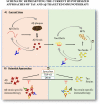Prospects for strain-specific immunotherapy in Alzheimer's disease and tauopathies
- PMID: 29507776
- PMCID: PMC5829136
- DOI: 10.1038/s41541-018-0046-8
Prospects for strain-specific immunotherapy in Alzheimer's disease and tauopathies
Abstract
With increasing age, as the incidence of Alzheimer's disease is increasing, finding a therapeutic intervention is becoming critically important to either prevent or slow down the progression of the disease. Passive immunotherapy has been demonstrated as a successful way of reducing large aggregates and improving cognition in animal models of both tauopathies and Alzheimer's disease. However, with all the continuous attempts and significant success of immunotherapy in preclinical studies, finding a successful clinical therapy has been a great challenge, possibly indicating a lack of accuracy in targeting the toxic species. Both active and passive immunotherapy approaches in transgenic animals have been demonstrated to have pros and cons. Passive immunotherapy has been favored and many mechanisms have been shown to clear toxic amyloid and tau aggregates and improve memory. These mechanisms may differ depending on the antibodie's' target and administration route. In this regard, deciding on affinity vs. specificity of the antibodies plays a significant role in terms of avoiding the clearance of the physiological forms of the targeted proteins and reducing adverse side effects. In addition, knowing that a single protein can exist in different conformational states, termed as strains, with varying degrees of neurotoxicity and seeding properties, presents an additional level of complexity. Therefore, immunotherapy targeting specifically the toxic strains will aid in developing potential strategies for intervention. Moreover, an approach of combinatorial immunotherapies against different amyloidogenic proteins, at distinct levels of the disease progression, might offer an effective therapy in many neurodegenerative diseases.
Conflict of interest statement
The authors declare no competing financial interests.
Figures

Similar articles
-
Prevention of tau seeding and propagation by immunotherapy with a central tau epitope antibody.Brain. 2019 Jun 1;142(6):1736-1750. doi: 10.1093/brain/awz100. Brain. 2019. PMID: 31038156 Free PMC article.
-
Tau immunotherapy in Alzheimer's disease and progressive supranuclear palsy.Int Immunopharmacol. 2022 Dec;113(Pt B):109445. doi: 10.1016/j.intimp.2022.109445. Epub 2022 Nov 18. Int Immunopharmacol. 2022. PMID: 36410182 Review.
-
Systemic vaccination with anti-oligomeric monoclonal antibodies improves cognitive function by reducing Aβ deposition and tau pathology in 3xTg-AD mice.J Neurochem. 2013 Aug;126(4):473-82. doi: 10.1111/jnc.12305. Epub 2013 Jun 16. J Neurochem. 2013. PMID: 23672786 Free PMC article.
-
Affinity of Tau antibodies for solubilized pathological Tau species but not their immunogen or insoluble Tau aggregates predicts in vivo and ex vivo efficacy.Mol Neurodegener. 2016 Aug 30;11(1):62. doi: 10.1186/s13024-016-0126-z. Mol Neurodegener. 2016. PMID: 27578006 Free PMC article.
-
Recent therapeutic strategies targeting beta amyloid and tauopathies in Alzheimer's disease.Brain Res Bull. 2019 Mar;146:171-184. doi: 10.1016/j.brainresbull.2019.01.004. Epub 2019 Jan 8. Brain Res Bull. 2019. PMID: 30634016 Review.
Cited by
-
Current Understanding of the Physiopathology, Diagnosis and Therapeutic Approach to Alzheimer's Disease.Biomedicines. 2021 Dec 14;9(12):1910. doi: 10.3390/biomedicines9121910. Biomedicines. 2021. PMID: 34944723 Free PMC article. Review.
-
Advances and considerations in AD tau-targeted immunotherapy.Neurobiol Dis. 2020 Feb;134:104707. doi: 10.1016/j.nbd.2019.104707. Epub 2019 Dec 10. Neurobiol Dis. 2020. PMID: 31841678 Free PMC article. Review.
-
Perspectives on the Role of APOE4 as a Therapeutic Target for Alzheimer's Disease.J Alzheimers Dis Rep. 2021 Dec 27;5(1):899-910. doi: 10.3233/ADR-210027. eCollection 2021. J Alzheimers Dis Rep. 2021. PMID: 35088039 Free PMC article. Review.
-
Soluble endogenous oligomeric α-synuclein species in neurodegenerative diseases: Expression, spreading, and cross-talk.J Parkinsons Dis. 2020;10(3):791-818. doi: 10.3233/JPD-201965. J Parkinsons Dis. 2020. PMID: 32508330 Free PMC article. Review.
-
Second-generation anti-amyloid monoclonal antibodies for Alzheimer's disease: current landscape and future perspectives.Transl Neurodegener. 2025 Jan 27;14(1):6. doi: 10.1186/s40035-025-00465-w. Transl Neurodegener. 2025. PMID: 39865265 Free PMC article. Review.
References
-
- Heron, M. Deaths: leading causes for 2010. National Vital Statistics Reports : from the Centers for Disease Control and Prevention 1–96 (National Center for Health Statistics, National Vital Statistics System, Hyattsville, MD, 2013). - PubMed
Publication types
Grants and funding
LinkOut - more resources
Full Text Sources
Other Literature Sources
Miscellaneous

